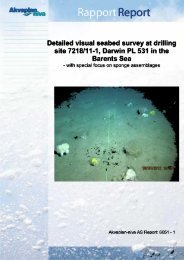A study of the priority substances of the Water Framework Directive ...
A study of the priority substances of the Water Framework Directive ...
A study of the priority substances of the Water Framework Directive ...
You also want an ePaper? Increase the reach of your titles
YUMPU automatically turns print PDFs into web optimized ePapers that Google loves.
� Cadmium is a toxic heavy metal, it is not<br />
found in pure state in nature<br />
� Cadmium has been used in pigments and batteries.<br />
Artificial fertilizers contain cadmium as a<br />
pollutant.<br />
� No fur<strong>the</strong>r screening is considered necessary,<br />
but monitoring <strong>of</strong> cadmium should continue.<br />
Production and use<br />
Cadmium is associated with zinc and non ferrous<br />
ores, and usually present in cement and<br />
phosphate fertilizer, as well as in fossil fuels.<br />
Cadmium has been widely used, in pigments<br />
and is still in widespread use in electronics metallurgy<br />
and for corrosive protection. In Norway,<br />
main use by 2002 was in batteries. Use in new<br />
produced or imported products has dropped<br />
from more than 40 tonnes annually in <strong>the</strong><br />
nineties to 27 tons in 2002. Cadmium pollutants<br />
in zink sacrificial anodes are now <strong>the</strong> single<br />
largest source, with 100 kilos in 2002.<br />
Production is stopped in Norway. Some compounds<br />
and uses are banned or regulated.<br />
Emissions, discharges,<br />
distribution and hot-spots<br />
Emissions have dropped from 43 tons in 1985,<br />
via 5 tons in 1995 to 1 tonne in 2003.<br />
Discharges to water in <strong>the</strong> same period have<br />
dropped from about 3,5 tons to about 600<br />
kilos. Main emissions come from products,<br />
industrial sources, and <strong>the</strong> oil and gas sector,<br />
but 29 percent <strong>of</strong> emissions in 2002 are "diffuse"<br />
or from "o<strong>the</strong>r" sources. Cadmium is a<br />
long range transboundary pollutant and<br />
increased levels are found in soil in South<br />
Norway. According to SFT almost 2/3 <strong>of</strong> <strong>the</strong><br />
annual cadmium pollutions come from sources<br />
outside Norway.<br />
Marine sediment<br />
Cadmium has been found in some harbours, but<br />
generally not in very high concentrations. The<br />
highest concentration was found in<br />
Henningsvær harbour in L<strong>of</strong>oten in Nordland<br />
County (class V).<br />
Marine biota<br />
Marine biota is generally moderately to markedly<br />
polluted by cadmium. In Sørfjorden in<br />
FACTS<br />
Cas no.: 7440-43-9<br />
cadmium and its compounds ::::::::::..<br />
6 Cadmium and its compounds<br />
Synonyms/compounds: Cadmiumchloride<br />
Cadmiumacetaat, Cadmiumoxide,<br />
Cadmiumhydroxide, Cadmiumsulfide,<br />
Cadmiumsulfate, Cadmiumsulfite.<br />
Properties: Metal. Not found in pure state in nature.<br />
Toxic effects: Cadmium and its compounds are toxic<br />
(acute and chronic) for mammals. They are listed as<br />
probable human carcinogens. Cadmium compounds<br />
are also very toxic to aquatic life forms, especially in<br />
fresh water (ClassLab, WHO, HSDB).<br />
Log Kow: -<br />
Persistence: Cadmium accumulates in soil, and plant<br />
uptake is a problem. Cadmium and its compounds<br />
do not form stable metal-organic complexes and are<br />
susceptible to changes in soil acidity. In water, cadmium<br />
is adsorbed to particulate matter. Cadmium<br />
accumulates in liver and kidneys in humans, while<br />
uptake <strong>of</strong> cadmium by daphnia, aquatic insects,<br />
molluscs, and crayfish is appreciable.<br />
<strong>Water</strong> solubility: Insoluble, some compounds are soluble.<br />
Molecular formula: Cd<br />
Cadmiumchloride: CdC l2<br />
Cadmiumacetate: C4H6CdO4 Cadmiumoxide: CdO<br />
Cadmiumhydroxide: Cd(OH) 2<br />
Cadmiumsulfide: CdS<br />
Cadmiumsulfate: CdSO 4<br />
Cadmiumsulfite: CdSO3 Metabolites: None<br />
Hordaland County, Harstad in Troms County<br />
and Årdalsfjorden in Sogn og Fjordane County<br />
<strong>the</strong>re are restrictions on consumption <strong>of</strong> shellfish<br />
due to high cadmium concentrations.<br />
Fresh water<br />
Since 1990 ten rivers have been monitored on a<br />
monthly basis and more than one hundred<br />
rivers on a yearly basis and cadmium levels are<br />
generally low. Rivers influenced with run<strong>of</strong>f<br />
from mines will have higher levels.<br />
A <strong>study</strong> <strong>of</strong> <strong>the</strong> <strong>priority</strong> <strong>substances</strong> <strong>of</strong> <strong>the</strong> <strong>Water</strong> <strong>Framework</strong> <strong>Directive</strong><br />
TA-2140/2005<br />
21:::..

















